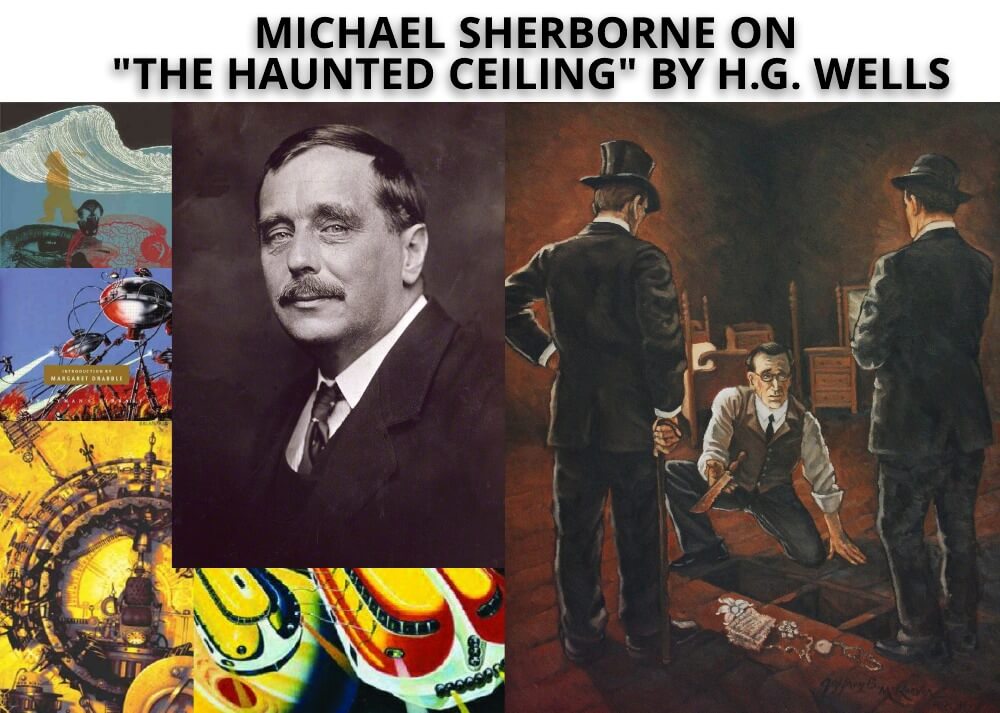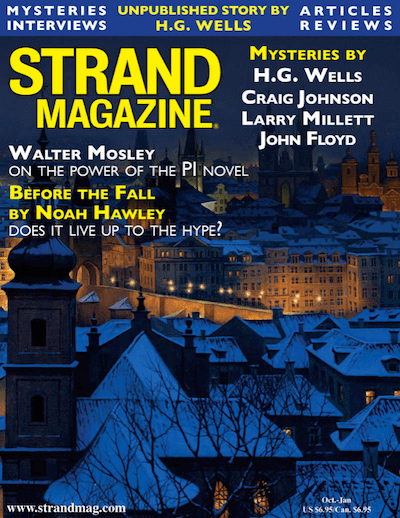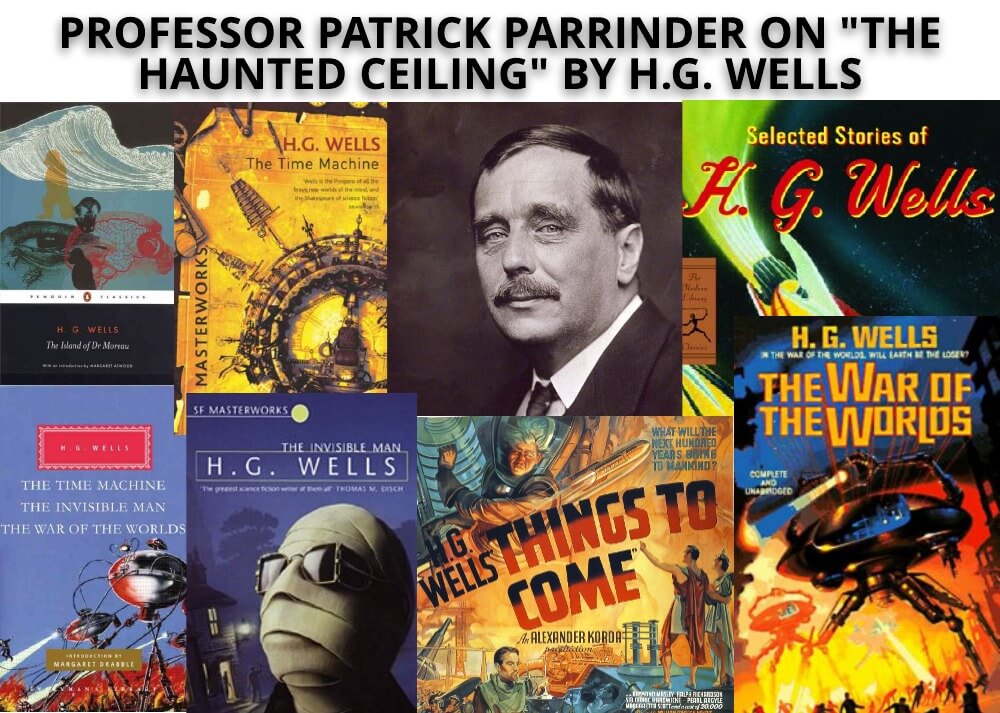
Unseen HG Wells ghost story published for first time
The Haunted Ceiling, a macabre story of strange goings-on in an old house, is thought to have been written in the mid-1890s
Sian Cain
The Guardian
Thursday 24 November 2016
Here’s a gothic tale for a stormy night: a man called Meredith converts a room in his house into a cluttered and untidy study, and one day asks a visiting friend if he can see anything strange on the ceiling.
“Don’t you see it?” he said.
“See what?”
“The – thing. The woman.”
I shook my head and looked at him.
“All right then,” he said abruptly. “Don’t see it!”
This is the beginning of a newly discovered HG Wells ghost story, called The Haunted Ceiling, a macabre tale found in an archive that Wells scholars say they have never seen before. It will be published for the first time this week, in the Strand magazine.
The story was discovered when Andrew Gulli, editor of the Strand, heard that the University of Illinois held a substantial archive of Wells’s works. He promptly hired an assistant to photocopy hundreds of manuscripts and sorted through them to see if he could find something new.
“Initially, from the titles of the manuscripts, I thought I happened upon lots of unpublished works, but those thousands of pages were narrowed down to this delightful story,” Gulli told the Guardian.
He called it “a vintage Wells story – you have a supernatural event, characters with two schools of thought on the event, [and] the literary type versus the scientist. This reminds me of his story The Red Room, but we have a more of a twist with The Haunted Ceiling.”
Wells scholars have dated the story to the mid-1890s, when the author was about 30. This would mean that he wrote The Haunted Ceiling around the same time he produced his more famous ghost tale, The Red Room, which depicts a sceptic’s terrifying night attempting to discredit claims a castle room is haunted.
While most famous for science fiction books like The Time Machine and The War of the Worlds, Wells frequently wrote gothic tales about doubters confronted with supernatural events, often leading to ambiguous and haunting endings. Stories like The Story of the Inexperienced Ghost, in which a man relates an occult encounter, then becomes more agitated until he collapses and dies. The narrator observes: “Whether he did indeed pass there by that poor ghost’s incantation, or whether he was stricken suddenly by apoplexy in the midst of an idle tale – as the coroner’s jury would have us believe – is no matter for my judging.”
The Haunted Ceiling is so obscure that two Wells scholars, Patrick Parrinder and Michael Sherborne, told Associated Press that they had never seen it before. Comparing the style and content to other Wells stories, they dated it to around 1895: a time when ghost stories were popular and Wells was both prolific and strapped for cash.
“So the puzzle is, why was this one either never sold, or if sold never published?” asked Parrinder, while Sherborne called it “not one of Wells’s very best stories, but it is a skilfully assembled anecdote which would, I think, be very effective as a self-contained magazine item.”
Gulli added: “The reason we released it now is to keep up the tradition of having ghost stories read during the cold months and during the holiday. There is something very cosy about it: the old house, the main characters playing chess and discussing this odd ceiling, but at the same time you have something very macabre and unsettling.”
Here’s a gothic tale for a stormy night: a man called Meredith converts a room in his house into a cluttered and untidy study, and one day asks a visiting friend if he can see anything strange on the ceiling.
“Don’t you see it?” he said.
“See what?”
“The – thing. The woman.”
I shook my head and looked at him.
“All right then,” he said abruptly. “Don’t see it!”
This is the beginning of a newly discovered HG Wells ghost story, called The Haunted Ceiling, a macabre tale found in an archive that Wells scholars say they have never seen before. It will be published for the first time this week, in the Strand magazine.
The story was discovered when Andrew Gulli, editor of the Strand, heard that the University of Illinois held a substantial archive of Wells’s works. He promptly hired an assistant to photocopy hundreds of manuscripts and sorted through them to see if he could find something new.
“Initially, from the titles of the manuscripts, I thought I happened upon lots of unpublished works, but those thousands of pages were narrowed down to this delightful story,” Gulli told the Guardian.
He called it “a vintage Wells story – you have a supernatural event, characters with two schools of thought on the event, [and] the literary type versus the scientist. This reminds me of his story The Red Room, but we have a more of a twist with The Haunted Ceiling.”
Wells scholars have dated the story to the mid-1890s, when the author was about 30. This would mean that he wrote The Haunted Ceiling around the same time he produced his more famous ghost tale, The Red Room, which depicts a sceptic’s terrifying night attempting to discredit claims a castle room is haunted.
While most famous for science fiction books like The Time Machine and The War of the Worlds, Wells frequently wrote gothic tales about doubters confronted with supernatural events, often leading to ambiguous and haunting endings. Stories like The Story of the Inexperienced Ghost, in which a man relates an occult encounter, then becomes more agitated until he collapses and dies. The narrator observes: “Whether he did indeed pass there by that poor ghost’s incantation, or whether he was stricken suddenly by apoplexy in the midst of an idle tale – as the coroner’s jury would have us believe – is no matter for my judging.”
The Haunted Ceiling is so obscure that two Wells scholars, Patrick Parrinder and Michael Sherborne, told Associated Press that they had never seen it before. Comparing the style and content to other Wells stories, they dated it to around 1895: a time when ghost stories were popular and Wells was both prolific and strapped for cash.
“So the puzzle is, why was this one either never sold, or if sold never published?” asked Parrinder, while Sherborne called it “not one of Wells’s very best stories, but it is a skilfully assembled anecdote which would, I think, be very effective as a self-contained magazine item.”
Gulli added: “The reason we released it now is to keep up the tradition of having ghost stories read during the cold months and during the holiday. There is something very cosy about it: the old house, the main characters playing chess and discussing this odd ceiling, but at the same time you have something very macabre and unsettling.”

Michael Sherborne
The Strand Magazine
23 November 2016
We had a chance to chat with Professor Michael Sherborne about “The Haunted Ceiling” an unpublished story by H.G. Wells which we’re publishing in the holiday issue of the Strand Magazine. Professor Sherborne was kind enough to share his expertise with us and speculate on why this short story was never published.
We had a chance to chat with Professor Michael Sherborne about “The Haunted Ceiling” an unpublished story by H.G. Wells which we’re publishing in the holiday issue of the Strand Magazine. Professor Sherborne was kind enough to share his expertise with us and speculate on why this short story was never published.
AG: When do you think that Wells wrote this story? It seems like a very old manuscript.
MS: It sounds like 1894-96. The opening paragraph uses the phrase “the darkness … grew apace,”which also occurs in The Time Machine. The opening of The Time Machine also features the wordpatent, liberal combination of dashes and brackets, a scene where professional men chat about strange topics, and the use of someone smoking to break up the dialogue. So early 1895 maybe? The story has a resemblance to “The Yellow Wallpaper” by Charlotte Perkins Gilman, which I think came out in 1892 in the USA; I don’t know if it had appeared in Britain, though.
AG: Physically it was very difficult to decipher and looking at his manuscript of The Time Machine, you could also see the writing was very tough to transcribe. Who transcribed the works of Wells?
MS: Wells’s wife edited and fair-copied his work. Her handwriting was virtually identical to his, but neater. I believe at this stage the typing was done by his cousin Bertha Williams.
AG: There is a mention of Sickert in the story; did Wells ever meet the artist?
MS: I’m not aware of any Wells-Sickert connection.

AG: What was his attitude toward ghosts and the occult? From the little that I know about Wells, he was a firm atheist but this story definitely has the feel of someone who ventured into a story about spirits.
MS: Wells had no time for the occult, but he knew there was money to be made from ghost stories. Although he was a champion of science, he understood that the universe was a mysterious place of which scientific knowledge was limited and provisional. In someone’s autobiography, maybe the cartoonist David Low, there’s a conversation where Wells admits this limitation and the writer retorts that it lets every superstition back into contention.
AG: His short story, “The Red Room,” was vintage Wells. How would you describe this story’s mood compared to some of the other horror stories that Wells wrote?
MS: “The Red Room” is feverish, even melodramatic, as are some Wells’s other horror stories. Some, of course, are comic like “The Inexperienced Ghost.” The very best. Like “ Elvesham,“ have a subtle mix of moods. I’d say “The Haunted Ceiling” was restrained and understated. Wells is trying to lull the reader into believing that there will be a simple, rational explanation, only to surprise us.
AG: Why do you think that Wells has not faded into obscurity like many of his contemporaries?
MS: There’s no short answer to this question unless we use that ambiguous word genius. There are so many aspects to Wells’s legacy and the best of his stories have so many strengths. Like all of us, he did, wrote, and said a huge amount of tosh, but there was also a part of him that was extraordinarily astute, a mixture of intuition and informed, wide-ranging intelligence, which cut through the jumble of appearances to see the truths and trends beneath.
AG: Are any of the themes of this story similar to anything else that Wells wrote?
MS: I think feminists could have a field day with this story. Impatience with the marriage bond runs through Wells’s work and life. Here, female presence is excluded from the story, with several examples of the narrator sniping at Meredith’s wife, but the repressed female element then returns accusingly in the form of the face in the ceiling. It could be relevant that the best-known book of verse by George Meredith, Modern Love, depicts a disintegrating marriage. Wells refers to it in a later short story, “Miss Winchelsea’s Heart.”
AG: How did these manuscripts end up in Illinois of all places?
MS: Wells died in 1946. At this period, having sold most of its assets and borrowed goods and money from the United States to fight two world wars, Britain was a financial wreck. (We only finished paying back the American loans in 2006.) The US, in contrast, was the wealthiest nation in history. No one in Britain could or would put up the money to buy the archive of a once-fashionable author, now rather looked down on by the elite. Professor Gordon N. Ray at Illinois could and did.
AG: Anything that readers you think should know about Wells?
MS: There’s so much! Everyone knows he was a science fiction writer, but he wrote many outstanding books of all kinds and was involved in so many activities and causes, not the least his work at the end of his life formulating and advocating human rights.
AG: What are your favorite Wells short stories and novels?
MS: Short stories: “The Country of the Blind,” “The Door in the Wall,” “The Star,” “The Story of the Late Mr. Elvesham,” “Under the Knife,” “The Man Who Could Work Miracles.” Novels: The Time Machine, The Island of Dr. Moreau, The War of the Worlds, Tono-Bungay, The History of Mr. Polly. Also two little-known novels from the 1920s: Christina Alberta’s Father and Mr. Blettsworthy on Rampole Island, which the publisher Peter Owen is reprinting next year with introductions by me explaining their merits!

The Haunted Ceiling by H. G. Wells analysed by Patrick Parrinder
Patrick Parrinder
The Strand Magazine
24 November 2016
We had the pleasure of interviewing Professor Patrick Parrinder who discussed the recently published short story by H.G. Wells titled, “The Haunted Ceiling.”
Gulli: When do you think that Wells wrote this story? It seems like a very old manuscript.
Parrinder: I agree with Mike (Professor Michael Sherborne) that he must have written it in the mid-1890s, when his output of short stories was at its greatest, as was his financial
dependence on writing and selling short fiction. So the puzzle is, why was this one either never sold, or if sold, never published?
One clue to its date is the pile of Athenaeums in Meredith’s room; the magazine closed in 1921, but rather lost its way after about 1900, as I remember, when it was in some ways superseded by the TLS.
Another is the reference to Sickert, though I can’t throw any other light on this. On the other hand, George Meredith was a very well-known English novelist who died in 1909. It might have been awkward to have published a story during his lifetime in which the main character, a “literary man,” bore his name.
Gulli: Physically it was very difficult to decipher, and looking at his manuscript ofThe Time Machine, you could also see the writing was very tough to transcribe. Who transcribed the works of Wells?
Parrinder: He had more than one typist who worked for him and regularly corrected the typed drafts, but like most handwriting, his gets easier to read with practice. There are one or two phrases in the transcription that had me wondering—for example, in the opening lines, was Meredith really always “leaving” his matches rather than losing them?
Gulli: What was his attitude to ghosts and the occult? From the little that I know about Wells, he was a firm atheist but this story definitely has the feel of someone who ventured into the spirits.
Parrinder: He wrote quite a few ghost stories in the 1890s, as did many other popular writers at the time, so was happy to respond to the demand for them. Sometimes the “ghost” has a pseudoscientific explanation in his writings, though in this one, the “scientist” may be able to explain the marks on the ceiling, but not their haunting effect.
Gulli: His other short story, “The Red Room,” was vintage Wells. How would you describe this story’s mood compared to some of the other horror stories that he wrote?
Parrinder: It has a more whimsical, comic aspect—the story of an untidy, whiskey-sodden, pipe-smoking “literary man” whose terror seems to be groundless until, in the end, it is explained and he is vindicated.
Gulli: Are any of the themes of this story similar to anything else that Wells wrote?
Parrinder: The scientist Bordell who, to some extent, explains the mystery, and the contrast between the “scientific” and the “literary” mind are typical of Wells.
Gulli: How did these manuscripts end up in Illinois, of all places?
Parrinder: Wells’s archive was auctioned after his death and was acquired on behalf of the University of Illinois by Professor Gordon Ray, best known for his biography of Thackeray. Unfortunately, Professor Ray never finished his projected Wells biography.
Gulli: Anything that you think readers should know about Wells?
Parrinder: A lot of Wells’s well-known short stories, like “The Star” and “The Country of the Blind,” are very different from this, but he wrote many remarkable stories of the paranormal: “The Plattner Story,” “Under the Knife,” “The Story of the Late Mr. Elvesham,” “The Door in the Wall,” and others.
Gulli: What are your favorite Wells short stories and novels?
Parrinder: Among his novels, The Time Machine, The War of the Worlds, The Invisible Man, Tono-Bungay, and others… but if you have got the Wells bug, you won’t stop there!









No comments:
Post a Comment